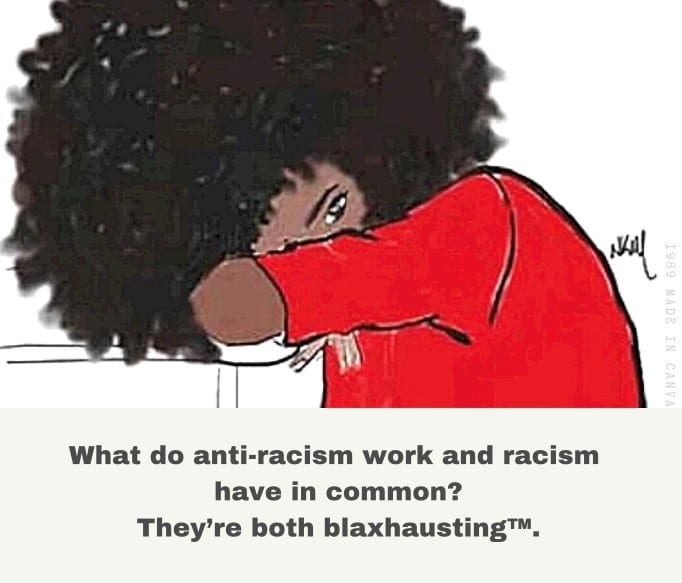First and foremost, can we agree that this work can be absolutely blaxhausting?! At the same time, this work is so necessary. Black educators, in this space, and especially Black women, often get the brunt of the burden. No surprise there. We can sometimes experience just as much misogynoir inside the (virtual) classroom as outside. “Subtle” assaults are still assaults. Unintentional racism is still racism.
Raise your hand if you’ve had days when you’re feeling frustrated and want to just say, “I’m done with this.” You are not alone. But have you also had days when, for example, you’ve gotten through to a senior leader who finally “gets it”? And then who takes action to overhaul processes in their organization? One person, one step, one process—that’s how we continue to move the needle.
It’s so important for all of us educators to keep going and pressing forward—and to do it without giving in to the inevitable hate. This work is way too valuable. YOU are way too valuable. Check out these five ideas that protect your peace and can prevent you from being sidelined.
- Reconnect with your “source” regularly. Recovery and renewal are critical to this work in order to avoid fatigue or burnout. Your source is defined as anything (or anybody) in your life that when you connect to it, it gives you a sense of passion, purpose, joy, serenity. Many of us have several sources which may include our faith practices, meditation, our family, nature, exercise, music, journaling, etc. Connecting regularly means never getting so busy that you inadvertently “forget.” To balance the huge toll on us that this work creates, consider your source to be as natural yet as vital to your existence as breathing.
- Establish boundaries. Let folks know upfront where you stand and what is and is not acceptable. This should ideally occur early on as part of your introduction or topic overview. For example, I let my clients know that I will prioritize their emotional and psychological safety but not their comfort. I also go on to tell them that I prioritize safeguarding my own emotional and psychological safety. For advanced topic workshops, I also invest time in having participants themselves articulate the distinction between safety and comfort, and then I stress the necessity of discomfort for growth and development. I also utilize pre-workshop assessments that prime participants for discomfort.
- Call on white people to address white people. There’s no need for you yourself to take on every racist or every bigot. Pick and choose your battles but also pick and choose white people to fight battles. When I’m facilitating, I will sometimes say, “Chris, what are your thoughts on Bill’s comment?” Not only does this ease the burden on me, but it also gives me an opportunity for micro-recovery (getting past my WTF reflex) before jumping back in and restoring equilibrium. When it’s a one-on-one coaching situation, have at the ready a predetermined question or phrase that stops the conversation in its tracks. For example, “That comment is an ouch” or “What’s the bias at the root of that comment?”
- Adjust your settings and limit social media. Many of us may have a pseudo “love-hate” relationship with social media. On the one hand, it allows for reaching a wider audience with our message, but, at the same time, social media is full of bigots and trolls who feel a sense of invincible boldness to attack both the message and the messenger. If you haven’t already, explore all the settings for each social media platform that you use and take advantage of every setting that allows you to block or minimize the trolling. For example, with LinkedIn, the “professional” platform, for your posts you can choose to allow comments from only your connections or you can choose to disable comments altogether. From there, determine days and times to be on social media that work best for you and establish your own rules of engagement. You can thank me later.
- Commit to micro-sabbaticals. Be purposeful and periodically go off the grid with a self-imposed “just for me” period. Based on what your circumstances will allow, be as “just me” as you can. No other people, no texts, no calls, no Zoom—just you doing what you want to do. Whether it’s half a day, a whole day, or a whole weekend, make a commitment to yourself. Put it on your calendar to help make it real and to help make it happen. And don’t schedule over it. This one may sound counterintuitive because of the sense of isolation some of us may feel due to the ongoing pandemic. Trust me on this one. The mindset and heartset of a purposeful micro-sabbatical is a major-shift game-changer. One of my best micro-sabbaticals involved island-hopping in the Caribbean thanks to a “Caribbean Life” binge on Hulu. Ahh…….
*For additional resources and ideas, Overcoming Gender Inequity: Real, Raw, Unapologetic Stories, Tips & Strategies and in The WarriHER’s Playbook on Well-Being and Self-Advocacy.
*For more on blaxhaustion and racial fatigue, Blaxhaustion, Karens & Other Threats to Black Lives and Well-Being
###
Your support of my work is greatly appreciated. Tangible ways to show your support include the following:
- your purchase of one or more of my four published books
- an Amazon review of one or more of my four published books
- an invitation to speak-for-hire to your team or organization
- a financial donation to support my future projects, which include the development of online courses
Pay Pal
Theresa M Robinson
Venmo
@Theresa-Robinson-1
Cash App
$tmr50
Thank you!
#blaxhaustion #blackwomen #antiracism #inclusion #selfadvocacy #wellbeing #wellness #leadership #activism


Recent Comments